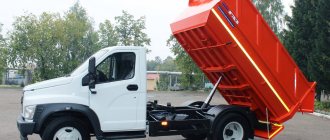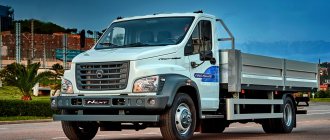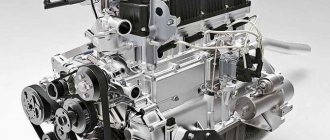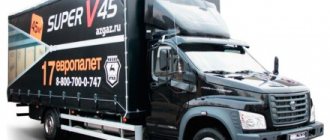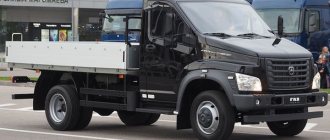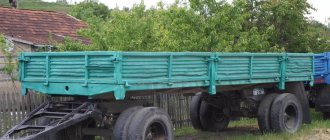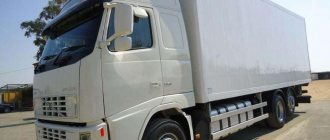"GAZon Next" - The Fifth Element
GAZon Next adopted most of the design and engineering solutions from the 2012 prototype and, in particular, the cabin module from GAZelle Next and a number of standardized parts, although the tail (plastic wings and radiator mask), instrument panel and even seats are different. There are some borrowings from the delivery GAZ-3310 Valdai. The result is a unique product, one of a kind: just remember that all other Russian-made medium-duty trucks are produced with cabs without a hood.
I suggest watching a short film first. Review and short excursion into the history of the creation of the GAZon NEXT truck.
The newest medium-tonnage truck is already the fifth generation of such GAZ vehicles, and it has the largest payload capacity in the series - 5 tons. Representatives of the fourth generation, GAZ-3307 and GAZ-3309, produced respectively from 1989 and 1994 to the present , capable of carrying 4.5 tons of cargo. True, the total circulation of such machines is very modest by Soviet standards - 300 thousand units. for almost a quarter of a century, while in the Soviet Union only GAZ-53 produced 330 thousand units. per year - twice as much as all European countries combined.
The GAZon NEXT cabin is one third wider than the GAZ-3307 cabin
The third generation cars, GAZ-52 (1966-1989) and GAZ-53 (1961-1993), had a cargo transportation permit of 2.5 tons each. The army and the national economy received a total of 4 million of these cars . The representative of the second generation, the GAZ-51, which stood on the assembly line from 1946 to 1975, carried the same amount of cargo. His series totaled 3.5 million units. The founder of the series can be considered the 1.5-ton GAZ-AA, which lasted in the series from 1932 to 1950. and distributed in the amount of 985 thousand copies.
Promising horizons
Updates to the mid-ton truck have been a long time coming. Is it a joke to say: the production of the GAZ-3307 began back in the days of the USSR! A quarter of a century has passed since then, more than one government has changed and more than one generation of competing cars has changed, but GAZon continued to be produced without noticeable improvements. The main characteristics of the vehicles remained the four-stroke 8-cylinder V-shaped carburetor engine ZMZ-5231.10 with a power of 124 hp. and a load capacity of 4.5 tons.
"GAZon Next" can be called a breakthrough product. Investments in the project exceeded 2.3 billion rubles. Compared to its predecessor, it has become more versatile. The radical difference is a more spacious cabin, increased glass area and increased living space. Instead of two seats, there are now three in the cabin, and seven in a two-row cabin. The Extended Cab's second-row seats can be folded down to become a sleeper.
Consumer qualities have been improved, and not least reliability: the design contains many imported components. True, this is also a minus: depending on the exchange rate, the retail price tag may change upward. A vehicle with a gross weight of 8.7 tons is capable of carrying 5 tons of cargo - 500 kg more than its predecessor. In the future, a 12-ton version with a load capacity of 6 tons will appear, followed by a truck tractor with a total weight of up to 18 tons.
LAWN NEXT finally has a normal handbrake. It is located under the driver's right arm. The width of the cabin allows accommodation for two passengers, equipped for any weather.
Representatives of the plant emphasize: “GAZon Next” is not a return to the concept of the diesel GAZ-4301 (1992-1995), but a new product that in the future will cover the entire line. Now it has basic modifications with an onboard steel and aluminum platform, a standard (3770 mm) and extended (4515 mm) wheelbase, a single-row three-seater or a two-row seven-seater cabin. The loading height of the steel body is 1300 mm, the euro platform is 1170 mm. There is only one drive so far - on the rear wheels (4x2), load capacity - 5 tons.
In the future, there will even be a gas version powered by methane. It is also possible to produce a three-axle vehicle with a lazy axle. The universal urban “GAZon City” will soon replace the “Valdai”. In 2015, the all-wheel drive version of the Sadko Next 4x4 with a payload capacity of 3 tons will take over from the regular Sadko. The off-road medium-duty truck will also be available with a regular and extended wheelbase, single-row and double-row cabs, but with single-pitch tires on the rear wheels instead of gable ones.
Who are the competitors?
The segment niche of medium-tonnage trucks in Russia has long been filled. Today, mainly Japanese and Korean brands compete here. But against their background, the new GAZ truck looks very decent. The key advantage of GAZon Next is the cost of ownership. The truck has the best price in its class - from 1.085 million rubles. The closest competitors in the form of Isuzu NPR 75, Mitsubishi Fuso Canter, Hyundai HD 78 cost half as much. For most of them, at the time of the release of GAZon Next, the price was set at a level of 1.65 million rubles. Consumables and spare parts for it are much cheaper than those of competitors. The service network is the most extensive, and spare parts can be purchased almost everywhere.
The low cost of ownership is facilitated by the service interval increased to 20 thousand km. On competitors' cars, on-board Hyundai HD 78 and Mitsubishi Fuso Canter, it is less - only 15 thousand km. Imported components from leading suppliers have increased the reliability of the vehicle. Due to the extensive use of galvanization and plastic, the truck is highly resistant to corrosion. The factory warranty is 3 years or 150 thousand km. Rivals like the onboard Isuzu Elf 7.5 have a warranty period that is a third shorter: 24 months or 100 thousand km. Even where the warranty time is the same (36 months), the manufacturer’s willingness to carry out mileage repairs at its own expense for Hyundai and Mitsubishi Fuso is more modest: 60 thousand km and 100 thousand km, respectively.
Rich base
The “donation” of the GAZelle Next cabin module benefited the new GAZon. The impressive glass area creates good illumination inside and provides decent frontal and side visibility. The cabin suspension on rubber-metal hinges will allow you to stay in good shape longer, and acceptable acoustic comfort will not cause increased driver fatigue, which means it will allow the driver sitting behind the wheel to maintain maximum concentration for longer. By the way, the sprung driver's seat has lumbar support and six types of adjustments.
The basic equipment is no match for the equipment of its predecessor. Electric windows, heated mirrors and cruise control are installed directly. ABS and ASR are included as standard. A pre-heater is available as an option. It allows you not to be afraid of frost and confidently revive the engine after a long stay, stabilizes the temperature of the engine and allows you to quickly warm up the cabin. For greater comfort, there is also additional equipment in the form of a heated driver's seat. In general, the difference compared to its predecessor is noticeable.
The pneumatic braking system used on the machine is borrowed from Valdai and is designed to operate a vehicle with a gross weight of up to 11 tons. It is characterized by efficiency and a large power reserve. The system requires little effort on the pedal and is highly reliable; in particular, it works even with slight depressurization. The handbrake has also become more convenient: now the parking brake valve is not a floor lever, but a “mushroom” in the form of a joystick. Fast-acting disc brakes provide short braking distances and are easy to maintain. The service life of the brake mechanisms reaches 200 thousand km.
The stylish appearance of the mid-ton truck is not deceptive: it hides excellent handling. The ZF integral steering mechanism is informative, convenient, and most importantly, it ensures precise control and stable straightness when driving on roads with different surfaces. For convenience, the CSR steering column is height adjustable. A nice detail: all steering gear components are maintenance-free. The optimal diameter and cross-section of the steering wheel, as well as the number of revolutions from lock to lock - 4.2.
"GAZon Next" received a new suspension. At the front, three reinforced leaf springs with high service life and reliability are used. The ends of the springs are embedded in rubber-metal hinges. The rear suspension has also been modernized. Anti-roll bars are used both front and rear. The measures taken improved the smoothness of the ride and ensured that straight-line motion was maintained during braking.
Based on operating experience, engineers strengthened the steel frame. Inside, a spar reinforcement and an inset rear bracket appeared. To install towing devices and a bumper, an original cross member has been added to the end part. The frame is fully adapted to work in Russian road conditions and is designed for increased load. In addition, it undergoes anti-corrosion treatment using cataphoresis.
Lucky Ley Line
The Yaroslavl diesel engine YaMZ-5344 is the most modern domestic engine, not only in Russia, but also in Europe as a whole. It has several power settings; when installed on the LAWN NEXT, the very minimum was removed from it, which is due to the technical characteristics of the car. In this case, the power is 149 hp, despite the fact that its maximum is 300 hp. The motor has a low level of noise and vibration, and when moving, the sound resembles a rich cat purr. Common Rail fuel equipment from Bosch is adapted for operation on Russian diesel fuel and ensures reliable engine starting at subzero temperatures. The car's electrical network has a voltage of 12 V.
The designers paid a lot of attention to the new gearbox. Previously, this unit caused a lot of complaints from consumers. With a factory warranty of 150 thousand kilometers, the old gearbox could simply ruin the entire GAZ Group service. Engineers changed the design of the housing, increased the thickness of the gears, and imported components were installed in problem areas. The synchronizer in all gears except first and reverse reduces effort. Gear shifting occurs clearly, there are no vibrations, and torque has been increased to 490 Nm.
The designers claim that they have made GAZon Next more reliable than its predecessor. In addition to the above components, the production of the new model uses the Autocomponent Visteon panel and instrument cluster, Tenneco shock absorbers (by the way, American), Wabco brake system, TRM cooling system and VibraCoustic engine mount. The list of foreign components does not end there. The Russian truck received a TIS sprung driver's seat, Brose electric windows, and Kiekert mechanical locks. All GAZon Next modifications use Edscha door fittings, Anvis cabin supports, Delphi heating and ventilation system, Aerodynamic Lighting headlights, ZF clutch and LUK hydraulic clutch.
Short and long
Until it comes to official sales, we will report a few figures characterizing the new product. “GAZon Next” model C41R13 with a standard platform has a length of 6475 mm, a width across the mirrors of 2755 mm, a height of 2335 or 2400 mm (depending on the size of the wheels) and a body measuring 3500x2190 mm. The car has a distance between the axles of 3770 mm, and short overhangs: 970 mm front and 1520 mm rear. The approach angle is 30 degrees, the departure angle is 18 degrees. Ground clearance is 189 mm on European 245/70 R19.5 tires or 253 mm on 8.25 R20 tires.
The factory workers left the same not only the dimensions of the frame, but also the points for mounting superstructures, which will be received with a bang by bodybuilders, and above all by manufacturers of manufactured goods and insulated vans. The final drive ratio for the universal model is 4.55, and for the City highway model it is 3.9. Distinctive parameters of the extended model C41R33: overall length 7960 mm, wheelbase 4515 mm, rear overhang 2275 mm, departure angle 12 degrees.
There is only one important detail: the long-wheelbase version has a composite frame rather than a single one. Its size is increased due to inserts in the middle part. The issue of lengthening the rear overhang is resolved in a similar way. Bodybuilders like mechanical engineering work with the frame in the same way. For economic reasons, Nizhny Novgorod residents did not create a solid frame. In addition, this would eliminate the possibility of assembling different generations of machines on one line of the conveyor, and in the current conditions this is an unaffordable luxury. However, that's another story.
There is every reason that the new LAWN NEXT will make adjustments to the existing market for cars with a carrying capacity of up to 5 tons. The cost of the basic configuration announced by the plant is a little more than one million rubles. In addition to the tempting price, the truck is made at a high quality level, plus a factory warranty. And one more absolute trump card of the LAWN, its hood - this sacred part of the truck evokes the inexplicable and universal love of drivers all over the world.
Prepared for participation in rally raids, GAZON NEXT has many awards and cups in its arsenal.
Technical characteristics of the GAZon NEXT car
TEXT: Alexander Trokhachev PHOTO: GAZ Group and DALNOBOI.ORG
